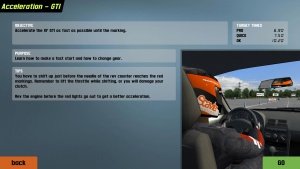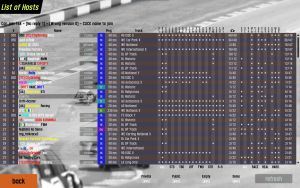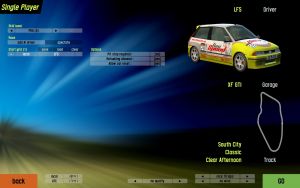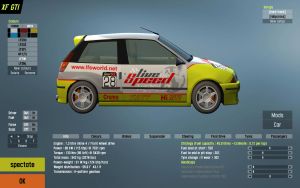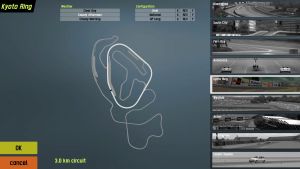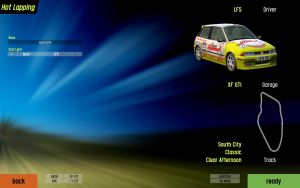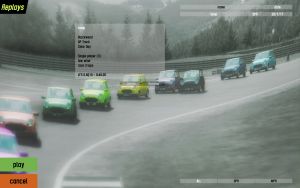Diferencia entre revisiones de «Modos de juego»
(Traducido entero) |
|||
| Línea 96: | Línea 96: | ||
'''Puerto del servidor:''' El puerto por defecto es el 63392 y normalmente no deberías tener que cambiarlo. Si, por algún motivo, el servidor no utiliza el puerto por defecto, puedes especificar el puerto correcto aquí. | '''Puerto del servidor:''' El puerto por defecto es el 63392 y normalmente no deberías tener que cambiarlo. Si, por algún motivo, el servidor no utiliza el puerto por defecto, puedes especificar el puerto correcto aquí. | ||
| − | === | + | === Crear servidor nuevo === |
| − | + | Por supuesto tú también puedes crear un servidor en Live for Speed. El número máximo de jugadores que pueden jugar en tu servidor se determinará basicamente por la velocidad de subida de tu conexión. El juego te muestra los cálculos del consumo de ancho de banda para que puedas ajustar el número de jugadores. Hay dos tipos diferentes de servidores. El primero es en el que tú estas corriendo. El segundo se conoce como servidor dedicado, no genera gráficos, por lo que sólo sirve para conectar a todos los jugadores. Para los dos tipos de servidores hay múltiples opciones que se describen más abajo:. | |
| − | ''' | + | '''Tipo de servidor:''' Esto es muy parecido a Unirse a un servidor concreto, pero además está la opción Oculto. Un servidor oculto se logeará en el servidor maestro, pero no estará visible en la lista de servidores. Solamente los jugadores que sepan el nombre exacto podrán entrar en él. |
| − | ''' | + | '''Nombre del servidor:''' Este es el nombre de tu servidor, que se mostrará en la lista de partidas, o si es un servidor oculto, el nombre que tendrán que introducir los jugadores que quieran unirse. |
| − | ''' | + | '''Contraseña del servidor:''' Escribiendo aquí una contraseña cambias el servidor de público a privado. Sólo los jugadores que sepan la contraseña podrán entrar en el servidor. Dejando la linea en blanco no se pedirá ninguna contraseña. |
| − | ''' | + | '''Contraseña del administrador:''' Configurando una contraseña de administrador te permitirá configurar el servidor de Live for Speed a distancia. El jugador que se conecte usando esta contraseña podrá modificar algunas opciones con unos comandos determinados. |
| − | '''IP | + | '''Dirección IP:''' Si tu servidor tiene más de una dirección IP puedes especificar cual debe usar el servidor LFS. |
| − | ''' | + | '''Puerto:''' Especifica que puerto tiene que usar el servidor para conectarse a internet. Normalmente podrás dejarlo como viene por defecto 63392.<br> |
| − | ADVICE: | + | ADVICE: Si el servidor se conecta a internet a través de un cortafuegos (firewall), los puertos TCP y UDP que usa LFS (default: 63392 and 29339) tienen que remitirse (http://portforward.com/routers.htm) al servidor. |
| − | '''Internet | + | '''Conexión a Internet:''' La configuración óptima del numero máximo de jugadores depende de tu conexión a internet. Solamente tienes que escoger la correcta en la lista. |
| − | ''' | + | '''Subida máxima:''' Si tu velocidad de subida no figura en la lista puedes especificarla tú mismo en la opción 'conexión a internet'. El valor tiene que estar es kBit/s.<br> |
| − | + | CONSEJO: Si sólo te sabes tu ancho de banda de subida en kByte/s o Mbyte/s puedes pasarlo a kBit/s:<br> | |
1 kByte/s = 8 kBit/s<br> | 1 kByte/s = 8 kBit/s<br> | ||
1 MByte/s = 8 MBit/s | 1 MByte/s = 8 MBit/s | ||
| Línea 134: | Línea 134: | ||
'''Allow vote (Kick/Ban):''' LFS allows the racers to kick or ban another racer by voting to do so. This has proven to be a good way to prevent people to destroy the races of others on purpose. If this option is set to 'No' only the server administrator will be allowed to kick or ban other racers. | '''Allow vote (Kick/Ban):''' LFS allows the racers to kick or ban another racer by voting to do so. This has proven to be a good way to prevent people to destroy the races of others on purpose. If this option is set to 'No' only the server administrator will be allowed to kick or ban other racers. | ||
| − | '''Allow track:''' If set to 'Yes' this allows the connected to choose the track they want to race on, otherwise only the server adminitrator will be allowed to choose a different track. | + | '''Allow track:''' If set to 'Yes' this allows the connected to choose the track they want to race on, otherwise only the server adminitrator will be allowed to choose a different track. |
== Singleplayer == | == Singleplayer == | ||
Revisión de 19:01 13 feb 2009
Entrenamiento
El nuevo modo de prácticas en Live for Speed se ha concevido como una escuela de conducción para ayudar a cualquier novato a familiarizarse con las técnicas de conducción necesarias para pilotar en circuitos. Por supuesto los veteranos de Live for Speed encontraran enormes beneficios viendo como refinar su estilo de conducción. Elige una lección de la lista y en la pantalla siguiente encontrarás la información de qué es lo que se pide para pasar la prueba. Después de terminar la prueba se te informará de cómo lo has hecho.
Tienes que superar las pruebas dentro del tiempo establecido y sin tocar ningún cono, o la prueba se dará por fallida. Clickando en el botón Multijugador te llevará a tu carrera virtual. Cuando juegues online recuerda siempre que compites contra otras personas, así que comportate bien. Conduce con cuidado y trata de evitar los accidentes. Pilotar sin juegos sucios no solo ofrece mejores tiempos por vuelta - hará que los demás quieran competir contra tí. El camino más rápido para empezar es haciendo click en "Mostrar lista de partidas" y elegir uno de los servidores. Por supuesto hay más opciones que ahora explicaremos.
Multijugador
Menú principal multijugador
Modo online: Esto te deja elegir si deseas competir con la versión Demo, S1 o S2. Tras escoger Demo, LFS se comportará como si no lo tuvieses desbloqueado. Sólo podrás competir con los coches y circuitos de la demo, y el número de jugadores estará limitado a 11. Esta opción es util para jugar con un amigo que (aún) no ha comprado el juego. Cuando creas una partida con el modo Demo activado, solo los jugadores que tengan la demo o el modo demo activado podrán ver y unirse a tu partida. Por supuesto puedes volver al modo S1 o S2 sin tener que desbloquear de nuevo el juego.
En ventana mientras se conecta: Cueando esta opción está activa, LFS se pondrá en modo ventana mientras se conecta. Esto es útil cuando tienes que activar la conexión a internet manualmente o cuando tienes un firewall que pide permiso para que el juego contacte con el servidor central de LFS. Si tu ordenador se conecta automaticamente a internet y el juego tiene libre conexión a internet puedes desactivar la opción.
Buscar un jugador: Como cada jugador de Live for Speed tiene un nombre único, puedes buscar un jugador desde el LFS. Introduce el nombre del jugador, y si está online, se te preguntará si te quieres meter en la partida en la que se encuentra.
Mostrar lista de partidas
Después de hacer click en este botón LFS se conectará al servidor principal y se descargará la lista de partidas disponibles que no estén ocultas. La lista contiene información de cada partida: qué coches están permitidos, el circuito y el numero de jugadores jugando y el máximo permitido. Clickando en el botón "?" verás información variada en la ventana del chat y el nombre de los jugadores de la partida. Utilizando los botones de la parte inferior podrás mostrar únicamente las partidas que cumplan tus requisitos.
Filtro de coches: Este filtro te ayudará a encontrar la partida que quieres.
El método RÁPIDO para usar estos filtros: Usa los botones de la derecha para definir el tipo de coches. Por defecto se muestran todos. Para afinar la búsqueda o la operación manual: Clicka en el nombre vertical de los coches en la lista de partidas. Puedes ponerlos en GRIS, AZUL o ROJO.
GRIS : No importa si el coche está activo o no
AZUL : Este coche TIENE que estar disponible
ROJO : Este coche NO DEBE estar disponible
- Deja la mayoria en GRIS (el color por defecto)
- TPon en AZUL los coches que te interesen
- Usa el ROJO solo para los coches que de verdad no quieres ver
Jugadores : por favor, uniros a partidas vacías - más gente se unirá!
Servidores : por favor, no permitais todos los coches, escocge un coche y otros de características similares. De esta forma darás la mejor experiencia a todos los jugadores.
Códigos de los coches: En la lista de partidas verás unos códigos que informan de los coches disponibles. Esta lista contiene los coches disponibles en S2:
UF1 - UF 1000 (S2) XFG - XF GTi (Demo, S1, S2) XRG - XR GT (Demo, S1, S2) XRT - XR GT Turbo (Demo, S1, S2) RB4 - RB4 GT (S1, S2) FXO - FXO Turbo (S1, S2) LX4 - LX4 (S1, S2) LX6 - LX6 (S1, S2) FZ5 - FZ 50 (S2) RAC - RaceAbout (S2) MRT - MRT5 (S1, S2) UFR - UF 1000 GTR (S2) XFR - XF GTR (S2) FOX - Formula XR (S2) FO8 - Formula V8 (S2) BF1 - BMW Sauber F1 (S2) FXR - FXO GTR (S2) XRR - XR GTR (S2) FZR - FZ 50 GTR (S2)
Códigos de los circuitos: Los circuitos también se indican con los códigos de la tabla siguiente. Cada configuración, excepto la pista de drag, se puede usar en sentido normal o invertido, duplicando el número de circuitos disponibles. El código del circuito es una combinación de tres partes: 1. Identificador de circuito, 2. Número de configuración y 3. Bandera de invertido. Ejemplo: BL1R significa "Blackwood GP Reverse", AS3 para "Aston National", etc.
BL - Blackwood (3 configs: GP, RallyX, Car Park) SO - South City (5 configs: Classic, Sprint 1, Sprint 2, City Long, Town Course) FE - Fern Bay (6 configs: Club, Green, Gold, Black, RallyX, RallyX Green) AS - Aston (7 configs: Cadet, Club, National, Historic, Grand Prix, Grand Touring, North) WE - Westhill (1 config : International) KY - Kyoto Ring (3 configs: Oval, National, GP Long) AU - Autocross (4 configs: Autocross, Skid Pad, Drag Strip, 8 Lane Drag)
Códigos de información: Cada servidor tiene una columna que te da información rápida de cómo está configurado, usando seis letras.
V - Votaciones (para expulsar/banear) permitidas S - Seleccionar el circuito está permitido Q - Clasificación activada (si no sólo hay carrera) M - Puedes unirte a la mitad de una carrera P - Parada en boxes obligatoria R - El servidor está conectado a Insim Relay
Chat: Cuando haces click en el botón una ventana de chat se muestra encima de la lista de partidas. Esto te permite encontrar a otros jugadores, quedar para correr o tan solo hablar un poco. Como en IRC hay varios comandos que puedes usar:
/find [nombreusuario] – te mostrará si el juegador está online, como el botón "Encontrar un jugador".
/users – te dirá el número de jugadores.
/hosts – te dirá el número de partidas.
/me [text] – muestra una accion propia???.
/leave – cierra el chat, como el botón "Salir".
/help – muestra la lista de todos los comandos disponibles.
Unirse a un servidor concreto
Esta opción te ayuda a localizar un servidor determinado, por ejemplo el de una liga o el de un equipo, sin tener que cargar toda la lista de servidores. Siempre que accedes a este menú figurará el último servidor en el que has estado. Esto permite volver a un servidor que has abandonado, por perdida de conexión por ejemplo.
Tipo de servidor: Aquí puedes elegir si el servidor va a ser por LAN o por Internet. Jugando por LAN, pueden jugar 3 jugadores con el mismo usuario de LFS. Así puedes jugar por LAN con gente que aún no ha comprado el juego. En el modo demo, también puedes elegir la opcion LAN si conoces la IP del servidor y no quieres que el juego se conecte al servidor principal. La opción 'Internet' hará que el juego se conecte al servidor principal. De Así pues, introducir el nombre de un servidor es suficiente información para establecer la conexión pero un nombre de usuario sólo puede estar online en un sitio.
Nombre del servidor: Introduciendo el nombre de un servidor te conectará directamente con él. Las mayusculas y los colores se ignoran.
Contraseña del servidor: Algunos servidores no están abiertos al publico porque los usan los equipos para entrenar o cualquier otro evento. Puedes acceder a ellos introduciendo la contraseña en esta pantalla. Muchos servidores, incluso los públicos, tienen configurada una clave de administrador. Si introduces esa contraseña podrás modificar ciertas opciones escribiendo determinados comandos a través del chat (ver comandos). Las mayusculas se ignoran, pero los colores tienen que coincidir.
Dirección IP del servidor: Tras escoger LAN (red local) como tipo de servidor, puedes introducír aquí su dirección IP.
Puerto del servidor: El puerto por defecto es el 63392 y normalmente no deberías tener que cambiarlo. Si, por algún motivo, el servidor no utiliza el puerto por defecto, puedes especificar el puerto correcto aquí.
Crear servidor nuevo
Por supuesto tú también puedes crear un servidor en Live for Speed. El número máximo de jugadores que pueden jugar en tu servidor se determinará basicamente por la velocidad de subida de tu conexión. El juego te muestra los cálculos del consumo de ancho de banda para que puedas ajustar el número de jugadores. Hay dos tipos diferentes de servidores. El primero es en el que tú estas corriendo. El segundo se conoce como servidor dedicado, no genera gráficos, por lo que sólo sirve para conectar a todos los jugadores. Para los dos tipos de servidores hay múltiples opciones que se describen más abajo:.
Tipo de servidor: Esto es muy parecido a Unirse a un servidor concreto, pero además está la opción Oculto. Un servidor oculto se logeará en el servidor maestro, pero no estará visible en la lista de servidores. Solamente los jugadores que sepan el nombre exacto podrán entrar en él.
Nombre del servidor: Este es el nombre de tu servidor, que se mostrará en la lista de partidas, o si es un servidor oculto, el nombre que tendrán que introducir los jugadores que quieran unirse.
Contraseña del servidor: Escribiendo aquí una contraseña cambias el servidor de público a privado. Sólo los jugadores que sepan la contraseña podrán entrar en el servidor. Dejando la linea en blanco no se pedirá ninguna contraseña.
Contraseña del administrador: Configurando una contraseña de administrador te permitirá configurar el servidor de Live for Speed a distancia. El jugador que se conecte usando esta contraseña podrá modificar algunas opciones con unos comandos determinados.
Dirección IP: Si tu servidor tiene más de una dirección IP puedes especificar cual debe usar el servidor LFS.
Puerto: Especifica que puerto tiene que usar el servidor para conectarse a internet. Normalmente podrás dejarlo como viene por defecto 63392.
ADVICE: Si el servidor se conecta a internet a través de un cortafuegos (firewall), los puertos TCP y UDP que usa LFS (default: 63392 and 29339) tienen que remitirse (http://portforward.com/routers.htm) al servidor.
Conexión a Internet: La configuración óptima del numero máximo de jugadores depende de tu conexión a internet. Solamente tienes que escoger la correcta en la lista.
Subida máxima: Si tu velocidad de subida no figura en la lista puedes especificarla tú mismo en la opción 'conexión a internet'. El valor tiene que estar es kBit/s.
CONSEJO: Si sólo te sabes tu ancho de banda de subida en kByte/s o Mbyte/s puedes pasarlo a kBit/s:
1 kByte/s = 8 kBit/s
1 MByte/s = 8 MBit/s
Maximum number of Guest PCs: This is the maximum number of PCs that will be allowed to connect to your server. This number does not necessarily match the number of racers that will be able to race on your server.
Maximum cars in race: This is the maximum number of cars that will be allowed to race on your server. This includes human racers as well as the AI.
Maximum cars per guest: This is the maximum number of cars every single guest PC might run on your server. This includes human racers as well as the AI.
Maximum cars on host: This is the maximum number of cars you will be able to race on your server.
Packets per second: Every second all the connected PCs receive data packets from the server which inform them about the positions of all the cars on the track. The more packets per second the PCs receive the more fluent the movement of all the other cars will be and thus the simulation will simply be more immersive. This value determines how many packets per second will be sent which hugely depends on the upload bandwidth of your internet connection. You should always try to keep this value as high as possible.
Dedicated: If you are using a PC to run the server, which does not offer enough 3D performance to properly run LFS in full graphic mode you can choose to run a so called dedicated server which only shows a summary of the connection. You will not be able to directly follow the race but you can still chat with the racers.
Allow vote (Kick/Ban): LFS allows the racers to kick or ban another racer by voting to do so. This has proven to be a good way to prevent people to destroy the races of others on purpose. If this option is set to 'No' only the server administrator will be allowed to kick or ban other racers.
Allow track: If set to 'Yes' this allows the connected to choose the track they want to race on, otherwise only the server adminitrator will be allowed to choose a different track.
Singleplayer
Even though Live for Speed was developed to offer the best online racing possible, its single player mode is not only a necessary addition but also very usefull in different aspects. The single player can be used to learn new tracks, develop setups or even practice some overtaking against the learning AI. If you make a mistake in single player mode, you will never anger anyone – except yourself, perhaps.
Skill Level: The speed of the AI can be varied from Beginner to Pro. Remember that the AI improves while racing and thus gets faster. On some tracks, the AI might be more than 5 seconds faster after an hour of racing. Every single AI behaves a little different so racing them will never get too boring.
Add AI driver: You can add up to 20 AI drivers to the race.
Join Race: This allows you to enter the race yourself. If you have already added 20 AI drivers to the race, you will not be allowed to join yourself as 20 is the maximum number of racers allowed.
Start Grid: This is a list of all participating drivers. Clicking on a drivers name will select this driver, clicking on the '-' in front of the name will remove the driver from the grid.
Swap Position: This button will only be visible when an AI has been selected from the grid. When you click on this button you will swap position with the selected AI in the grid.
Player: This button directly takes you to the player's options, allowing you to change the name, the driver model you use and your nationality.
Garage: This button takes you to the pits where you can set up and tune your car.
Track: This button lets you choose the track, its configuration, the weather and the time of day.
Laps: The grey buttons allow you to choose how many laps you want to race. Choosing 0 laps will start an unlimited practise session which probably is the best way to learn new cars and tracks as you can do as many timed laps as you want. Additionally, this is the mode that allows you to train your AI over night. As soon as you select 1 or more laps to race, an additional control appears which lets you choose if you want to have a qualifying before the race and how long it should be. Right below the number of laps you can select how much wind you want to have. There are three levels of wind: none, low and strong. The direction and the actual strength is set by a random function.
INFORMATION: The number of laps is limited to a max of 255.
ADVICE: Right-Clicking on the buttons will change the value in steps of 10.
Game Lobby Screen
In the game lobby screen you will set up your single and multiplayer races. Here you can choose your car, including it's skin and setup, the track and set up how long you want to race.
Let’s examine the buttons you can access and their usage. You can see a skill level button labelled pro with an arrow at each end, this button controls the level of intelligence for the AI (Artificial Intelligence) clicking on the left arrow lowers the value, the right increases the value, newbie is the lowest value and starting point, pro is the highest level.
The next button under the skill level is the add AI button this adds a robot car to LFS ready to race against you or against another AI car or the clock; up to twelve AI can race at any one time or eleven AI against you, the racer in offline mode. AI racing is fun and a great way to learn the tracks, racing lines etc., AI can consist of different cars against each other, due to similar outputs and abilities many LFS racers have pitted the GTi against the GT and close racing & great spectator fun has always ensued.
The join race button is self explanatory; this allows you to add your car, manned by you and join in the fun. Looking now to the group of buttons to the right of the screen, we see that the next button is called the player button.
Garage Area and Car Settings
Next we have the main screen you probably will deal with in LFS, this is the garage area, it is here you select your car type, create, add and delete setups and modify all kinds of stuff. Most of these buttons are very easy to figure out and largely self-explanatory, starting from top left we see the car colours panel.
The car colours panel allows you to add, delete and modify the colour schemes of your own prepared skins and some LFS supplied skins. Clicking on the individual colour icon, or using the new button to add a new named skin to the list, from a pop up selection of named skins in the LFS/skins folder.
Under the colour panel is the driverand force panel, this allows you to turn on force lines to show the level of force on the car and add a driver and rotate and bounce the car. Have a play around with it and see the difference stiffer suspension, driver weight, has etc.
The vertical row of buttons (right) contain your car setups for the pictured car type, to change car selection you select the car button. The new button will allow you to make a copy of the currently selected setup, (you then make changes to the new one preserving the original) delete removes the selected setup from the list and LFS.
The most important part on this screen is the horizontal row of car setup buttons, as the naming suggests you can alter the settings of many components here. Info is the only one that cannot be changed, it merely provides info about each car in terms of specifications regarding weight, power output etc.
This whole area has its own separate guide to allow you get the most out of the ability to customise your car for optimum performance and fun. However, briefly, you will notice that all sub menus have sliders to increase or decrease the selected values. Using the sliders you may also right-click on any slider to directly type in the value or you can copy and paste values with Strg-right-click and Shift-right-click respectively.
Make a copy of the default hard track setup by highlighting it, click new to create a copy and save under a different name and play around with the settings by increasing or decreasing items, use small adjustments at first etc, when finished click OK to return to the Single Player screen and add to race by clicking the join race button.
Track Selection
Next we will cover the last button the tracksselection button, pretty important as we need a safe place to race our cars, hey? You will see a small map showing the selected track from an overhead view and details on the overall length of that track, next to the tracks button are buttons that set the type of race at the selected track, the race length and wind speed if any. They are:
Qualifying, this sets the qualifying time in minutes or can be disabled so there is no qualifying for this race race 1, this shows the selected number of laps in the current race, This can be as high as 255 laps or as low as 1 lap, also decreasing the counter to zero sets the session to practice, this is an untimed free session.
Wind has three settings, no wind, low wind and high wind. The wind direction and speed is randomized by LFS and it will have a noticable impact on your laptimes!
There are six major track areas for racing, the sevenths area Autocross is a skid pad zone for building tracks and experimenting, as well as a two and eight lane drag strip area. To use a track, simply select the desired track from the main areas on your right, this will bring a submenu containing all the tracks available for that particular raceway. You can then choose which of the separate tracks to race on by clicking on that track name. A map showing the track layout is then displayed, and options to change the weather conditions (lighting only) are available from the weather menu, with its three options:
BRIGHT CLEAR - OVERCAST - CLOUDY SUNSET/DUSK - You have to make the choice! At this stage of LFS development actual weather conditions, such as rain, hail, fog etc have not been implemented, nor has night racing.
Clicking the OK button will lock in the selected track and options you have chosen and return you to the Single Player selection screen where you can join the race and start racing by clicking the GO button.
Hotlapping
In hotlapping mode you can try to compete with the best drivers in the world without even going online.
This mode puts you on the track in a controlled and perfect environment and lets you fight against the clock. But you should be careful not to leave the road or hit an object while trying to improve your lap times as the HLVC (HotLap Validity Check) will constantly watch what you are doing and mark any lap as invalid which was not clean. In the top right corner of the screen you will see the fastest valid lap you have done and the last split times you did. After you have done a lap that was a personal best and that was marked as valid by the HLVC, you can upload it to http://www.lfsworld.net, compare your time to the official world-record time and see how you rank against all the other racers out there.
Saved replays you can find in data\spr folder. Best way to save replay is to press '1' key, this saves replay file with automatic name in format youraccountname_track_car_time.spr, eg. somebody_AS1_UF1_10883.spr. To name replay file yourself, press '2' key. To upload a replay, open S2 Hotlaps in LFS World, and go to tab Hotlap Charts.
You can access the hotlap database from online game, see 'LFS World statistics commands for in-game usage'.
TIP: Replays of all the laps that have been uploaded to LFS World can be downloaded and then watched on your PC. This is the perfect way to study the racing line of the world's best drivers and improve your own laptimes.
Replays
One of the great features of LFS is the ability to record a replay of each race, whether it be a Single Player Race (SPR) or a Multiplayer Race (MPR, LAN or Online). Watching a replay you can use various camera-perspectives, speed-up, slow-down or even pause the play back. The appropriate hotkeys are listet in the key commands chapter. To record a race it is customary to set this feature in the Options/Game section as we discussed before, however you can save a recorded session by hitting the 2 key on the main keyboard , this saves the race up until that point and immediately starts the saved replay playing back, this is useful when you have just finished an online race and want to save it before everyone restarts.
During a single player replay, if you hit the esc key, you will be presented with some options:
Options: Takes you to main options screen
Replay: Restarts the selected replay
Output lap data: Saves technical information to a .RAF (Repay Analyser File) that you import into external programs, such as LFS Replay Analyser,Analyse For Speed or F1PerfView available from the Live For Speed main site.
Test drive: This allows you to drive using someone’s replay file. Say you dl a World record holders replay and want to see how you do in their car! You may have to change your controller settings to suit if they use a wheel and you use kbd etc .first.
